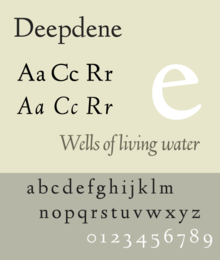|
Deepdene (typeface)
Deepdene is a serif typeface designed by Frederic Goudy from 1927–1933.[1] It belongs to the "old-style" of serif font design, with low contrast between strokes and an oblique axis. However, Deepdene has crisp serifs and a nearly upright italic, with much less of a slant than is normal for this style.[1] Issued by the American branch of Lanston Monotype, Deepdene was popular on its release and often used for the body text of books.[2][3][4] Several digitisations have been created. Deepdene is named after Goudy's home in Marlborough-on-Hudson.[3][5][6] This was itself named for the road on which he previously lived in Queens, New York.[7][8] Design Goudy described the design as loosely inspired by "a Dutch type which had just been introduced;" Goudy's friend Paul Bennett suggested in later life that this was Jan van Krimpen's Lutetia although Walter Tracy writes that the attribution cannot be certain.[9] He also later created a medium weight, bold and bold italic.[1] Goudy's biographer D. J. R. Bruckner praised the design as "the type that brings together the most characteristics of Goudy types the best".[3] Goudy later created a blackletter design, Deepdene Open Text and the derived Deepdene Text, which was intended to complement it for purposes such as initial capitals.[a] The designs are not related otherwise.[1] The family in metal type included:
Digitisations Deepdene has been digitised and released by several organisations and software companies. P22's digitisation under their LTC imprint perhaps uniquely includes the swash capitals and small caps in italics.[10] The open-source "League of Movable Type" project has released an open-source digitisation, "Linden Hill", by Barry Schwartz, in regular and italic with swashes but without bold weights.[11] References
Notes
External links
|
||||||||||||
Portal di Ensiklopedia Dunia
